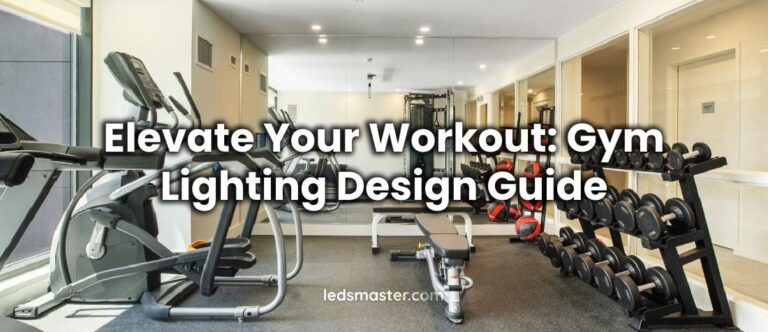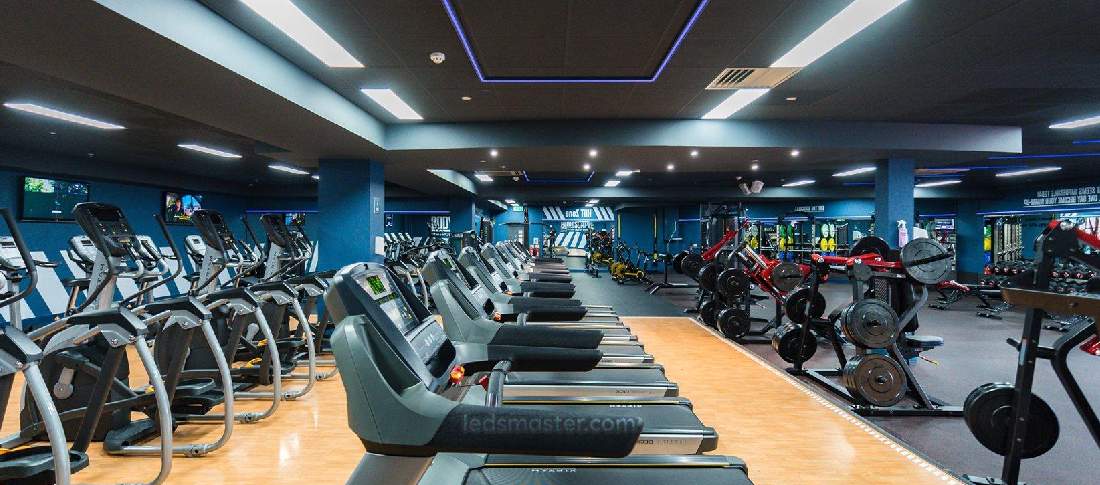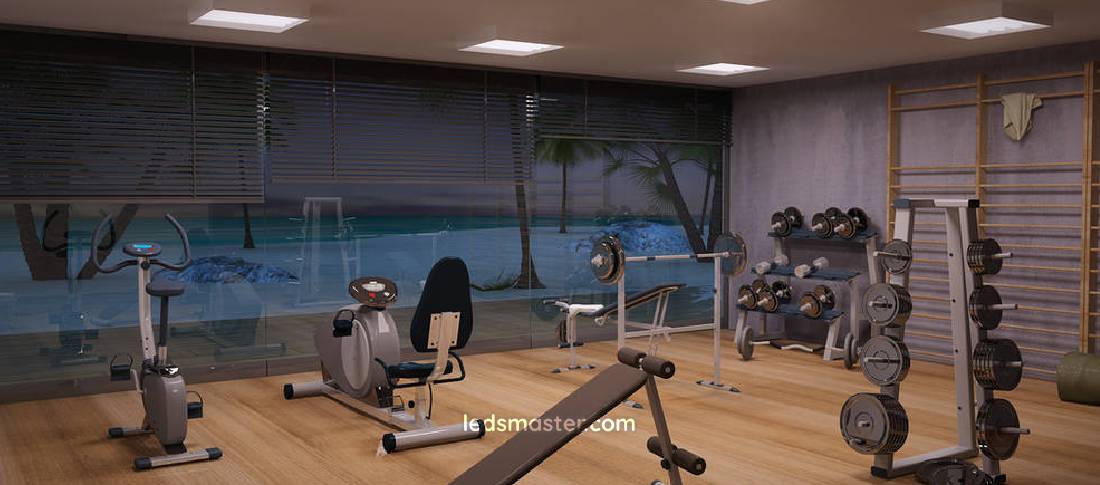
Effective lighting design can elevate a workout from routine to energizing, enhancing safety and performance. LED technology offers gyms versatile lighting solutions that boost motivation, create an inspiring atmosphere, and optimize the entire fitness space.
Get your complimentary lighting design today
Whether for an indoor fitness center or an outdoor sports facility, the right lighting design can enhance performance, motivate users, and ensure a safe workout environment. As LED technology continues to evolve, it offers remarkable solutions for gym lighting, combining energy efficiency, longevity, and superior performance. This article explores the essential aspects of gym lighting design, with a particular focus on the benefits of LED lighting and considerations for both indoor and outdoor gyms.
Lighting in a gym is more than just a necessity; it is a fundamental aspect of creating an environment conducive to exercise and well-being. The right lighting design can influence mood, focus, and overall performance. Proper illumination helps in preventing accidents, ensuring that users can see clearly and avoid potential hazards. Additionally, well-designed lighting can enhance the aesthetics of the space, making it more inviting and energizing.

Lighting design is a fundamental aspect of creating functional and inviting indoor gym spaces. The right lighting enhances the user experience, promotes safety, and optimizes the overall atmosphere. When planning the lighting for an indoor gym, several factors come into play, including the choice of lighting technology, appropriate brightness levels, color temperature, control systems, and energy efficiency.
Table of Contents
ToggleLight Emitting Diodes (LEDs) have gained immense popularity in gym lighting design due to their numerous advantages over traditional lighting options. One of the most significant benefits of LED lighting is its energy efficiency. LEDs convert a larger proportion of energy into visible light compared to incandescent or fluorescent bulbs, which waste a significant amount of energy as heat. This efficiency leads to reduced energy consumption, resulting in lower electricity bills for gym owners and a more comfortable environment for users.
In addition to energy efficiency, LEDs boast an impressive lifespan, often exceeding 25,000 hours. This longevity means that gym facilities will spend less time and money on maintenance and replacements. Traditional bulbs may require frequent changing, which can disrupt operations and incur additional labor costs. With LED lighting, gym managers can allocate resources more effectively, focusing on other areas of facility management rather than routine maintenance of lighting fixtures.
The durability of LED lights further enhances their suitability for gym environments. Unlike fragile incandescent bulbs, LEDs are more resistant to shock, vibration, and temperature fluctuations. This resilience is particularly advantageous in a gym setting, where equipment and activities can generate significant movement and noise. Choosing LED fixtures means gym owners can invest in lighting solutions that can withstand the wear and tear associated with high-traffic areas.
Achieving optimal lighting levels enhance the functionality of various workout areas within a gym. Different spaces serve distinct purposes and require specific illumination strategies to create an ideal environment for users.
A well-lit cardio area keeps users motivated and focused, which can significantly enhance their workout experience. Bright lighting can create an energizing atmosphere, encouraging individuals to push themselves during their exercise routines. Properly positioned fixtures can minimize shadows, ensuring that users have a clear view of their surroundings and equipment.
Strength training areas require a different approach to lighting design. A combination of general and task lighting is most effective in these spaces. General lighting provides overall illumination, while task lighting focuses on specific equipment, ensuring that users can see what they are doing clearly. For instance, higher intensity lighting can be directed toward weightlifting stations or exercise machines to enhance safety and precision during workouts. Good visibility reduces the risk of accidents and helps users maintain proper form during exercises, ultimately leading to better results.
Group exercise rooms present unique challenges regarding lighting design. These spaces often host a variety of classes, from high-energy spin sessions to calming yoga practices. Adjustable lighting options are beneficial in creating different atmospheres depending on the class type. For high-intensity workouts, brighter, dynamic lighting can stimulate energy and motivation. Conversely, for yoga or meditation classes, softer, ambient lighting can foster relaxation and tranquility. By incorporating versatile lighting solutions, gyms can cater to the diverse needs of their clientele, enhancing the overall user experience.
Color temperature is a significant aspect of lighting design that affects the mood and functionality of an indoor gym. Measured in Kelvin (K), color temperature influences how the light appears and how it impacts users’ perceptions. For indoor gyms, cooler color temperatures—typically ranging from 4000K to 5000K—are often preferred. This range mimics natural daylight, promoting alertness and reducing eye strain for users engaged in physical activities.
CRI measures the accuracy with which a light source renders colors compared to natural light. Higher CRI values indicate better color accuracy, which is particularly valuable in fitness environments where users may be selecting apparel, assessing body mechanics, or following instructor-led classes. Selecting LED fixtures with a high CRI ensures that colors appear true to life, enhancing the overall visual experience within the gym.
The interplay between color temperature and CRI contributes to creating an inviting and functional environment. When users feel comfortable and can accurately perceive their surroundings, they are more likely to engage in their workouts and spend additional time in the gym. This factor ultimately supports the gym’s goals of encouraging fitness and promoting a healthy lifestyle.
Modern LED lighting systems often come equipped with dimming capabilities and sophisticated control systems. These features allow gym managers to adjust lighting levels according to specific activities, time of day, or occupancy. The ability to customize lighting creates a more dynamic and tailored experience for users.
For instance, during evening yoga classes, dimmable lights can be adjusted to create a soft, calming atmosphere that enhances relaxation and focus. Conversely, during high-energy spin sessions, lighting can be ramped up to provide an invigorating environment that stimulates motivation and engagement. The flexibility offered by dimmable systems allows gyms to cater to various activities throughout the day, creating a more inclusive and enjoyable environment for all users.
Integrating control systems that monitor occupancy or follow a set schedule can lead to energy savings as well. By ensuring that lighting is used only when necessary, gyms can minimize their energy consumption and contribute to sustainability goals. Smart lighting solutions that adjust based on real-time data can further enhance efficiency, providing a win-win scenario for both facility managers and gym-goers.
The design of lighting for outdoor gyms poses unique challenges and opportunities. As outdoor fitness spaces gain popularity in parks and recreational areas, selecting appropriate lighting technology becomes essential for ensuring user safety and satisfaction.
LED lighting is particularly advantageous for outdoor gym installations due to its durability and weather resistance. Unlike traditional lighting options, LEDs are designed to withstand various environmental conditions, including rain, snow, and extreme temperatures. This resilience ensures that outdoor lighting systems remain functional and effective year-round, providing consistent performance regardless of the weather.
Given the extensive use of outdoor spaces, especially during evenings, the reduced energy consumption associated with LED lighting translates into lower utility bills. Additionally, the long lifespan of LED fixtures reduces the frequency of replacements, minimizing maintenance efforts and costs associated with outdoor installations.
Adequate lighting coverage is essential to ensure that all areas are well-lit, eliminating dark spots that could pose risks to users. Pathway lights and area lights should be strategically positioned to achieve comprehensive coverage of the workout area.
Floodlights are particularly effective for illuminating larger open spaces within outdoor gyms. These fixtures provide wide coverage and high-intensity light, making them suitable for areas where multiple users may engage in various activities simultaneously. Achieving a balance between brightness and uniform coverage is crucial, as overly bright spots or dark areas can detract from the user experience.
Enhancing security in outdoor gym environments is an consideration in lighting design. Well-lit spaces deter criminal activity and foster a sense of safety among users. High-intensity floodlights should be strategically placed around the perimeter of the gym to provide clear visibility, ensuring that all areas are well-monitored.
Incorporating motion-sensor lights can further enhance security measures. These lights automatically activate when movement is detected, providing illumination when it is needed most. This approach not only improves safety but also conserves energy by ensuring that lights are only on when the space is occupied.
The environmental impact of lighting design for outdoor gyms is a consideration that cannot be overlooked. Light pollution can disrupt natural ecosystems and wildlife, so employing LED fixtures with appropriate shielding and directional lighting is essential. By minimizing light spill and directing illumination precisely where it is needed, outdoor lighting designs can enhance visibility for gym users while protecting the surrounding environment.
Implementing environmentally conscious lighting solutions demonstrates a commitment to sustainability and community responsibility. Outdoor gyms can serve as models for responsible design, promoting healthy habits while minimizing their ecological footprint.
LEDs are particularly favorable due to their long lifespan and minimal maintenance requirements. For outdoor installations, choosing weatherproof fixtures resistant to vandalism ensures that the lighting systems remain functional and visually appealing over time.
Regular maintenance checks ensure the longevity and performance of the lighting systems. However, the inherent durability of LED technology reduces the frequency and intensity of maintenance efforts. By investing in high-quality lighting solutions, gym managers can create environments that are not only functional but also aesthetically pleasing.
Energy efficiency remains a consideration in the design of gym lighting, whether for indoor or outdoor spaces. The adoption of LED technology results in substantial energy savings compared to traditional lighting solutions like incandescent or fluorescent bulbs. This reduction in energy consumption leads to lower utility bills, positively impacting the facility’s bottom line.
In addition to the financial benefits of reduced energy use, the decreased need for frequent bulb replacements results in further cost savings related to maintenance and operational expenses. These factors make LED lighting an economically wise choice for gym owners, facilitating a more sustainable approach to facility management.

Lighting can also be used creatively to enhance the aesthetics of a gym. For indoor spaces, incorporating different light fixtures, such as pendant lights, wall sconces, or accent lighting, can add visual interest and complement the gym’s design theme. For outdoor gyms, architectural lighting can highlight features such as gym structures or landscaping, creating a visually appealing environment that attracts users and enhances the overall experience.
Gym lighting design is a component in creating a functional, safe, and motivating environment for users. LED lighting stands out as the preferred choice due to its energy efficiency, durability, and superior performance. Whether for indoor or outdoor gyms, LED technology provides optimal illumination, enhances safety, and contributes to a more enjoyable workout experience. By carefully considering factors such as lighting levels, color temperature, and environmental impact, gym owners and designers can create spaces that inspire and support users in achieving their fitness goals.